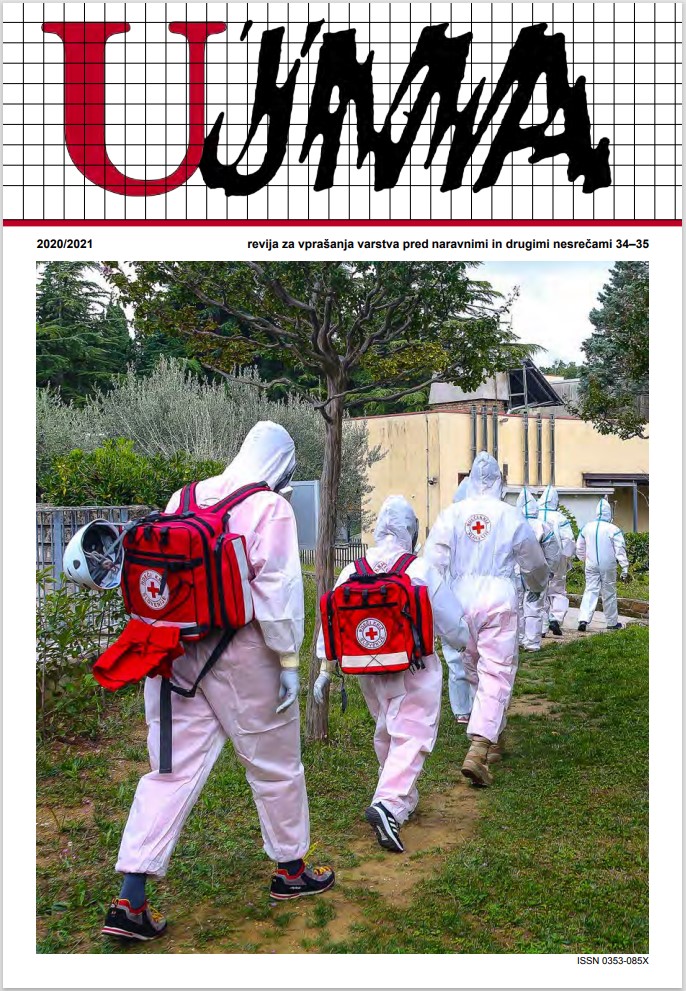APPROACHES TO BETTER IDENTIFICATION OF CYANOBACTERIA AS A THREAT TO HUMAN AND ENVIRONMENAL HEALTH
Abstract
Increased pollution of surface waters is one of the most serious global environmental problems. Water resources intended for drinking water supply, recreational or irrigation waters, and abundant fish farming areas are of particular concern. An increased load of nutrient nitrogen and phosphorus compounds causing eutrophication, in combination with other favourable environmental factors, often leads to massive growth of aquatic phytoplankton. Cyanobacterial “blooming” (intense growth) poses a disturbance and danger to the environment, and their active metabolic products – cyanotoxins – threaten the health of living organisms, including humans. Cyanotoxin poisoning in Brazil in 1996 contributed vigorously to the development of regulatory phytoplankton monitoring approaches worldwide, and later to new preventive methods. Many Slovenian surface water bodies are also polluted with organic and inorganic matter, which causes regular or occasional toxic or non-toxic cyanobacterial blooms. There are various options for preventive actions, detecting the threat of cyanotoxins on the one hand and raising people’s awareness of the risk of occurrence on the other. It is important that we implement all activities properly and in a timely manner, thereby enhancing broader awareness of the magnitude and power of natural organisms and accepting socially responsible care for all water resources.
References
Agencija Republike Slovenija za okolje, ARSO, 2018. Kakovost kopalnih voda v Sloveniji, Poročilo za leto 2017; ARSO, Ljubljana, 23.
Azevedo, S. M. F. O., Carmichael, W. W., Jochimsen, E. M., Rinehart, K. L., Lau, S., Shaw, G. R. in Eaglesham, G. K., 2002. Human Intoxication by Microcystins During Renal Dialysis Treatment in Caruaru – Brazil. Toxicology, 181–182(0), 441–446.
Bittencourt-Oliveira, M.C., Piccin-Santos, V., Moura, A. N., Aragão-Tavares, N. K. C., Cordeiro-Araújo, M. K., 2014. Anais da Academia Brasileira de Ciências, 86(1), 297–309.
Bubik, A., Sedmak, B., Novinec, M., Lenarcic, B., Lah, T. T., 2008. Cytotoxic and Peptidase Inhibitory Activities of Selected Non-hepatotoxic Cyclic Peptides from Cyanobacteria. Biological Chemistry, 389(10), 1339–1346.
Bubik, A., 2012. Ekološki, biološki in biokemični učinki nekaterih pogostih ne-hepatotoksičnih cikličnih cianopeptidov (n-hCCP), doktorska disertacija. Univerza v Ljubljani, Medicinska fakulteta, 145.
BRASIL, 2011. Regulation MS Nº 2914, Guidelines for drinking Water Quality, Official Law Report’s, 12. december 2011.
Carmichael, W. W., Azevedo, S. M., An, J. S., Molica, R. J., Jochimsen, E. M., Lau, S., Rinehart, K. L., Shaw, G. R., Eaglesham, G. K., 2001. Human Fatalities from Cyanobacteria: Chemical and Biological Evidence for Cyanotoxins. Environmental Health Perspectives, 109(7), 663–668.
Codd, G. A., Azevedo, S. M. F. O., Bagchi, S. N., Burch, M. D., Carmichael, W. W., Harding, W. R., Kaya. K., Utkilen, H. C., 2005. CYANONET, a Global Network for Cyanobacterial Bloom and Toxin Risk Management: Initial Situation Assessment and Recommendations. UNESCO IHP-VI.
Elersek, T., Milavec, S., Korošec, M., Brezovsek, P., Negreira, N., Zonja, B., de Alda, M. L., Barceló, D., Heath, E., Ščančar, J., Filipič, M., 2016. Toxicity of the mixture of selected antineoplastic drugs against aquatic primary producers. Environmental Science and Pollution Research, 23(15), 14780–14790.
Eleršek, T., Plazar, J., Filipič, M., 2013. A method for the assessment of DNA damage in individual, one day old, zebrafish embryo (Danio rerio), without prior cell isolation. Toxicology in Vitro, 27(8), 2156–2159.
Elersek, T., Ženko, M., Filipič, M., 2018. Ecotoxicity of disinfectant benzalkonium chloride and its mixture with antineoplastic drug 5-fluorouracil towards alga Pseudokirchneriella subcapitata. PeerJ, (6), 1–14.
Filipič, M., Žegura, B., Sedmak, B., Horvat - Žnidaršic, I., Milutinovič, A., Šuput, D., 2007. Subchronic Exposure of Rats to Sublethal Dose of Microcystin-YR Induces DNA Damage in Multiple Organs. Radiology and Oncology, 41(1), 15–22.
Leese, F., Bouchez, A., Abarenkov, K., Altermatt, F., Borja, Á., Bruce, K., Ekrem, T., Čiampor, F., Čiamporová-Zaťovičová, Z., Costa, F. O., Duarte, S., Elbrecht, V., Fontaneto, D., Franc, A., Geiger, M. F., Hering, D., Kahlert, M., Kalamujić Stroil, B., Kelly, M., … Weigand, A. M. (2018). Why We Need Sustainable Networks Bridging Countries, Disciplines, Cultures and Generations for Aquatic Biomonitoring 2.0: A Perspective Derived From the DNAqua-Net COST Action. Advances in Ecological Research, 58, 63–99. https://doi.org/10.1016/bs.aecr.2018.01.001.
Mantzouki, E., Lürling, M., Fastner, J., de Senerpont Domis, L., Wilk-Woźniak, E., Koreivienė, J., Seelen, L., Teurlincx, S., Verstijnen, Y., Krztoń, W., Walusiak, E., Karosienė, J., Kasperoviienė, J., Savadova, K., Vitonytė, I., Cillero-Castro, C., Budzynska, A., Goldyn, R., Kozak, A., … Ibelings, B. W., 2018. Temperature effects explain continental scale distribution of cyanobacterial toxins. Toxins, 10(4). https://doi.org/10.3390/toxins10040156.
Namikoshi, M., Rinehart, K. L., 1996. Bioactive Compounds Produced by Cyanobacteria. Journal of Industrial Microbiology and Biotechnology, 17(5), 373–384.
Palíková, M., Krejcí, R., Hilscherová, K., Babica, P., Navrátil, S., Kopp, R., Bláha L., 2007. Effect of Different Cyanobacterial Biomasses and Their Fractions with Variable Microcystin Content on Embryonal Development of Carp (Cyprinus carpio L.). Aquatic Toxicology, 81(3), 312–318.
Sedmak, B., Kosi, G., 1997. Microcystins in Slovene Freshwaters (Central Europe) - First Report. Natural Toxins, 5(2), 64–73.
Sedmak, B., 2006. Toksicne cianobakterije: prebivalstvo proti vodi – medsebojna Pretnja = Toxic Cyanobacteria: Population Against Water – a Mutual Threat. UJMA, 137–143.
Svetovna zdravstvena organizacija, 2017. Guidelines for drinking-water quality, 4th edition, incorporating the 1st addendum, WHO Publishing, Geneva.
Šuput, D., Milutinović, A., Serša, I., Sedmak, B. 2002. Chronic Exposure to Cyanobacterial Lyophilisate Reveals Stronger Effects Than Exposure to Purified Micricystins - a MRI Study. Radiology and Oncology, 36(2), 165–167.
Vasselon, V., Domaizon, I., Rimet, F., Kahlert, M., Bouchez, A., 2017. Application of high- throughput sequencing (HTS) metabarcoding to diatom biomonitoring: do DNA ex- traction methods matter? Freshwater Science 36, 162–177.
Žegura, B., 2016. An Overview of the Mechanisms of Microcystin-LR Genotoxicity and Potential Carcinogenicity, Mini Reviews in Medicinal Chemistry, 16(0), 1–21.
https://youtu.be/VIKk9LVRqho, 19. 4. 2021.
https://youtu.be/YWHTAwmqmOU, 19. 4. 2021
Downloads
Published
Issue
Section
License

This work is licensed under a Creative Commons Attribution-NonCommercial-NoDerivatives 4.0 International License.
The articles are made available to the public under Creative Commons Attribution-NonCommercial-NoDerivatives 4.0 International (CC BY-NC-ND 4.0).


